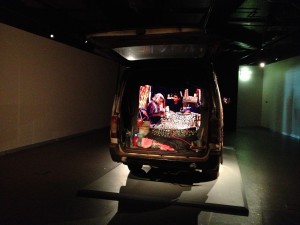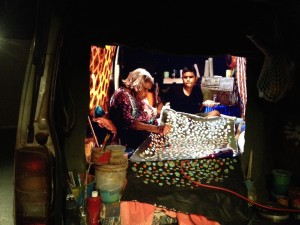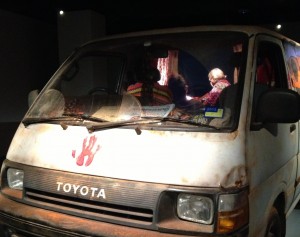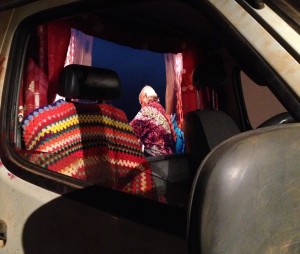Remote Aboriginal communities are sites of polarity. Yirritja and Dhuwa, Garth Brooks and Azealia Banks, boundless flood-plains and land permits, transcendent beauty and Third World squalor. Were you a privileged white girl with an art-history degree you might find a two-year stint at one of the epicentres of this opposition—a community art centre—divergently exhausting and exhilarating. You might feel your education building moment-to-moment, in tandem with new awareness of your ignorance. You might return to Melbourne feeling inadequate, barking at anyone who dares ask for your opinion on the intervention, thawing out in a puddle of tears.
Warwick Thornton’s 14-minute film installation, now showing at ACMI after premiering at dOCUMENTA, is based on Bertolt Brecht’s Mother Courage and her children. Set against the carnage of the Thirty Years’ War (ask me why they call it that—it’s the only piece of war-related trivia I ever remember), the play follows a morally bankrupt canteen-lady whose decisions lead to the deaths of her three children. Brecht’s text illustrates the mercantile nature of war. It asks reader and audience to contemplate what price Mother Courage pays for her survival.
Believe it or not, Brecht’s apocalyptic, ideologically complex play is also seriously funny. After an attack leaves her daughter permanently disfigured, Mother Courage consoles her by pointing out that she won’t be the first girl raped by soldiers. Later, rumours of peace send Mother Courage into a funk, representing nothing more than her own financial ruin. Presumably Brecht was having too much fun writing the awfulness of the title character to provide a satisfactory explanation for his naming another one ‘Swiss Cheese’.
Thornton’s Mother Courage sits cross-legged on a mattress in the back of a dilapidated camper-van somewhere on the outskirts of Alice Springs, slowly filling a canvas on her lap with coloured dots. Her stoicism cuts against the fidgeting of her young grandson, squashed in beside her—polishing off Cheezles, drinking no-name cola, twiddling the volume knob of his ghetto blaster. A DJ dedicates his broadcast to Aboriginal prisoners.
Thornton sees his matriarch as ‘an empowered, resourceful sort who is reinventing herself and her culture’. I’m inclined to see her more as a victim of the worsening social reality of remote communities than an agent of cultural prosperity. In any case, Mother Courage captures the compromises made by those whose survival is at stake, and the disconnect between the conditions under which ‘tradition-based’ Aboriginal art is made, and the art market that consumes it. If none of that interests you, be seduced by one Central Desert boy’s aspirations to air guitar virtuosity.
Warwick Thornton, Mother Courage, ACMI, Melbourne, 5 February – 23 June 2013.





